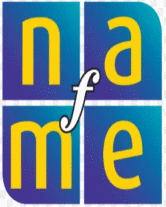Students in grades 9-12 learn how their part fits into an ensemble by silently playing their instruments while another part of the class plays aloud.
Performing on instruments, alone and with others, a varied repertoire of music: Students perform with expression and technical accuracy a large and varied repertoire of instrumental literature with a level of difficulty of 4, on a scale of 1 to 6.
Since much time in rehearsal is spent working with groups of instruments, the teacher asks all of one section to play while the remainder of the students follow along, silently bowing or practicing the fingerings for the notes in their parts. Alter listening to the "solo section," students comment on what they heard, how the sound could be improved, and what role (melodic, rhythmic, or harmonic) the section is playing at thattime in the music. Through this process, the students learn to listen to other sections ofthe ensemble as well as their own, thus helping the group to improve its balance.
Standard 2a
Performing on instruments, alone and with others, a varied repertoire of music: Students perform with expression and technical accuracy a large and varied repertoire of instrumental literature with a level of difficulty of 4, on a scale of 1 to 6.
Procedures
Since much time in rehearsal is spent working with groups of instruments, the teacher asks all of one section to play while the remainder of the students follow along, silently bowing or practicing the fingerings for the notes in their parts. Alter listening to the "solo section," students comment on what they heard, how the sound could be improved, and what role (melodic, rhythmic, or harmonic) the section is playing at thattime in the music. Through this process, the students learn to listen to other sections ofthe ensemble as well as their own, thus helping the group to improve its balance.
Individual students, as well as sections, may be asked to play a portion of a work while the other members of the ensemble listen and evaluate the performance according to criteria understood by all. The performances may be recorded and placed in the individuals' or sections' portfolios. This gives students a chance to receive counsel from their peers in the ensemble and to track their improvement over time.
The instructional activity is successful when:
- The students play their parts with increasing accuracy in moderately difficult music.
- The students explain how their part fits into the total ensemble.
Excerpted from Teaching Examples: Ideas for Music Educators.

| Provided in partnership with NAfME |
Students in grades 9-12 learn how their part fits into an ensemble by silently playing their instruments while another part of the class plays aloud.
Subjects
TYPE:





